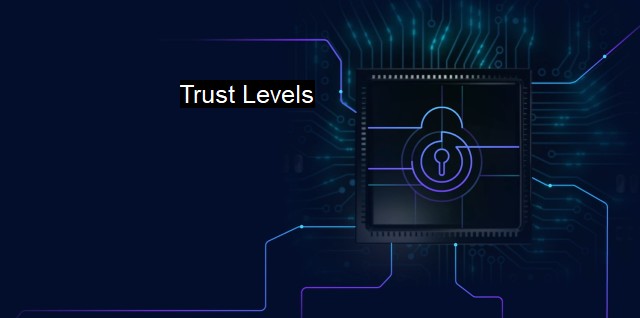What are Trust Levels?
Understanding Trust Levels in Cybersecurity and Antivirus: Safeguarding Users from Malicious Threats
Trust levels are instrumental mechanisms that help determine the extent to which a particular application or system has privileges of interacting with data or processes within an ambit defined by the security system. This is essentially a kind of categorisation derived from assignment defined by system vendors, governance bodies, security administrators, among others, relative to the perceived level of threat, system integrity or security posture tied to the usage or interaction of such applications or service objects.The concept of trust levels is critical in safeguarding organizational IT systems from both internal and external threats while ensuring that business operations run smoothly. They help in the delineation and enforcement of predefined rules and clearances for various tiers of software, individuals, or even hardware interacting with the propriety bio-space of an organization's IT system. These viewports defining the trust levels are in themselves an offshoot of the system, kernel prerogative commands defined singularly on principles rooting in risk management policies, limitation of service broadcasts through access controls, and administrative defaults preset uniquely for each system.
Defining trust levels adds layers of security and assists in vulnerability management. It helps establish a plinth of security postulates filtering out non-stipulated operations, assigns privileges to trusted applications, and restricts operations of those that are not designated as trusted. When an object or application is ranked on this trust level and consequently attempts to interact, the security software is tagged to respond per the definitions within the trust level. Considering that different applications need varying degrees of interaction with system resources, setting up trust levels allows control mechanisms to be implemented for systems seepage and to reinforce firewalls' capacities where desired.
In relation to antivirus software, trust levels play a significant role. Antivirus software needs to intermingle more intrinsically than any other application with the system. They examine disk files, monitor loaded programs, and periodically latch onto network stream traffic to abbreviate the leakage flow. Here, the trust level for such exclusively invasive a software, as an antivirus, is absolute; and herein lies a unique challenge. Since antivirus software operates at the highest trust level, it can be both the staunchest custodian and fieriest foe, alternately.
If an attacker gains control of antivirus software, they have the potential to infiltrate all systems and gain expansive control, making "trust" the centripetal crux of cybersecurity systems. Logically, the rise of trust levels led to the establishment of a reverse taxonomy of 'Least Privilege Principle' or 'Zero-Trust Policy'. The principle suggests offering bare minimum privileges required to execute their job role rather than loading with open-ended access, thereby upgrading the overall protection strategy.
Zero Trust philosophy questions trust levels within the system. At each checkpoint, every user, device, network transaction must authenticate, authorize, and continuously validate security configuration and posture, significantly mitigating the likelihood of undiscovered or clandestine threats.
While the existence of trust levels enhances the cybersecurity landscape's resilience in dynamic virtual breakthrough and architectural sagacity, they inevitably have challenges that need constant navigation. The inherent fragmentation could prolong the identification of a threat entity on the system's backdrop. Often, a hybrid solution combining optimum trust levels with Zero Trust and other cutting-edge technologies offers the most resilient protection.
The idea of trust levels remains a pervasive element in structuring successful adamant cybersecurity blueprint robust enough to significantly diminish the proliferation of uncertainty, threats with its dual shield tactic of providing as much hardened isolation as desired yet nourishing enough interactivity for processes to run their methodic ferment seamlessly. It helps enshrine the lesser mortality prospect twist angle against the spiraling mal intent codes that simulcast a pseudo-immersion onslaught into system barracks often caught unflared due to the masking convenience of the age of digital diversion.

Trust Levels FAQs
What are trust levels in cybersecurity?
In cybersecurity, trust levels refer to a system of assigning levels of trust to different applications or processes based on their potential risks and threats to the security of a system.Why are trust levels important in antivirus software?
Trust levels are important in antivirus software because they help to determine how an application should be handled based on the level of trust it has been assigned. This helps to prevent malicious applications from causing harm to a system.What factors determine the trust level of an application?
Several factors can determine the trust level of an application, including its source, digital signature, behavior, and reputation. Applications that are downloaded from trusted sources and have a valid digital signature are typically given a higher trust level than those that do not.Can trust levels be adjusted in cybersecurity?
Yes, trust levels can be adjusted in cybersecurity depending on the level of security required for a particular system. Adjusting trust levels can help to mitigate potential security risks and ensure that only trusted applications are allowed to run on a system.| | A | | | B | | | C | | | D | | | E | | | F | | | G | | | H | | | I | | | J | | | K | | | L | | | M | |
| | N | | | O | | | P | | | Q | | | R | | | S | | | T | | | U | | | V | | | W | | | X | | | Y | | | Z | |
| | 1 | | | 2 | | | 3 | | | 4 | | | 7 | | | 8 | | |||||||